The greatest exodus from the capital and one of the country's biggest national holidays is just a day away.
During the Seollal Lunar New Year's Day holiday, travelers who embark on their journey home, hoping to spend the five-day holiday with their loved ones, will face jam-packed train stations and bus terminals. On the road, there will be an endless march of vehicles crawling along at a snail’s pace.
Despite the logistical tie-ups, all travelers have an excited and eager air, as they look forward to soon reuniting with their family. Everyone travels with both hands full of Seollal gifts for grandparents, parents, siblings and relatives.
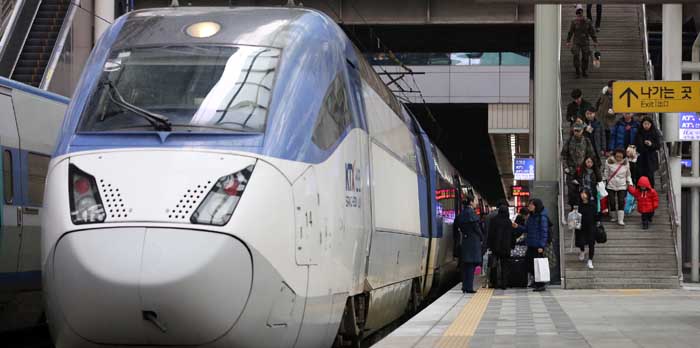
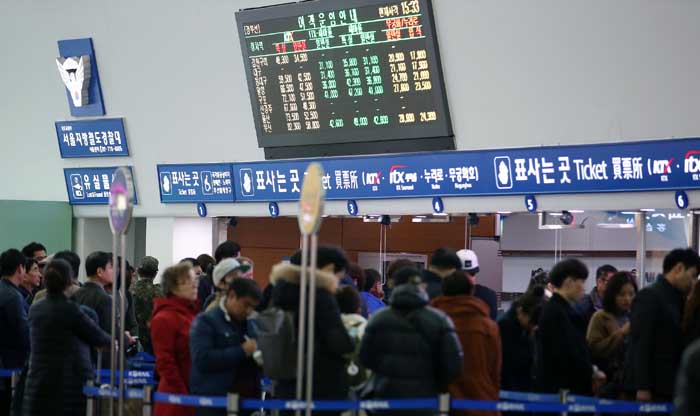
Technically, this year’s Seollal holiday falls on Wednesday. February 18, and continues until February 20. The following weekend of February 21 and 22 gives people a five-day vacation.
Many people chose to take off the Monday and Tuesday, too, allowing for a much earlier mass exodus from Seoul.
According to the Ministry of Land, Infrastructure and Transport, some 33,540,000 people are predicted to migrate to their hometown across the nation during this holiday.
The figure increased by 15.7 percent over last year's figure, an increase of 4.56 million people. On February 19, the very day of Seollal, as many as 7.03 million people are expected to travel out of the capital.
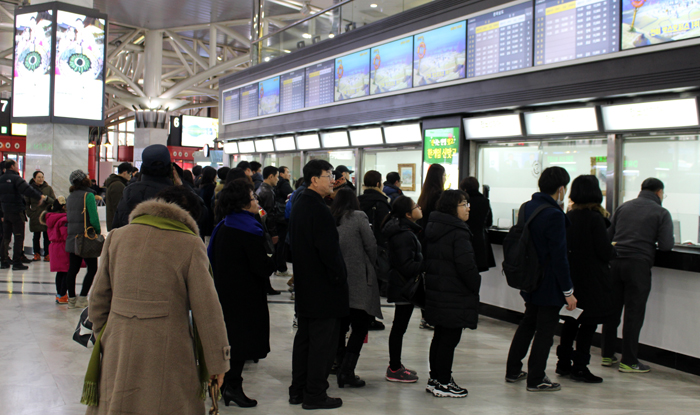
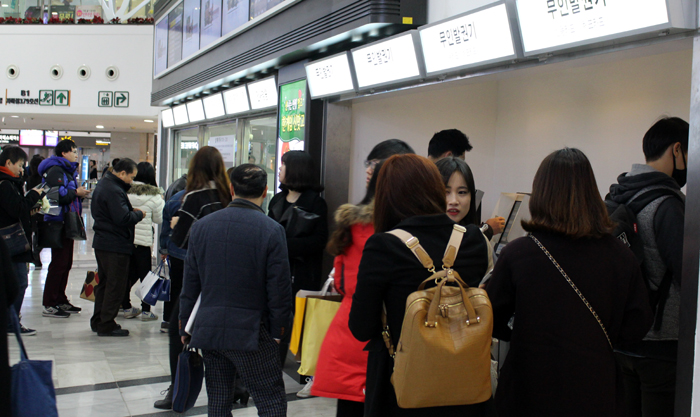
The solar new year starts on January 1, but in Korea, it’s still symbolically meaningful to celebrate the Lunar New Year,.
On Lunar New Year’s Day, people return to their hometown in earnest to spend the holiday with their families, who are scattered all over the country or the world.
A lot of traffic on the road makes the journey home take far longer than usual. For example, it takes twice or three times as long to travel from Seoul to Busan during the holiday. The trip normally takes four or five hours. Train tickets and bus tickets, too, sold out many weeks ago.
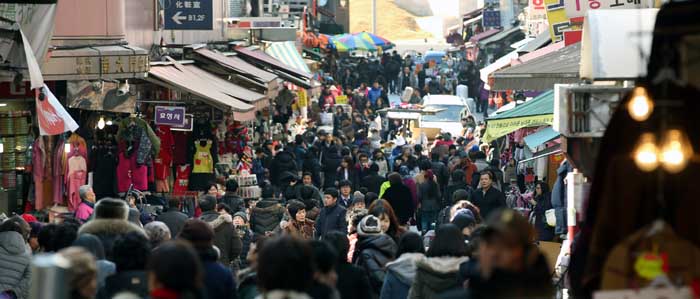
Traditional markets, too, are gearing up to welcome all the customers who come to buy traditional food items. These are placed on the table when people perform ancestral rites, part of the Seollal tradition.
Vendors are busy pulling out stacks of rice cake from the machine, known as a garaetteok. Rice cakes are the main ingredient of ttekguk, a rice cake soup traditionally eaten on Seollal. Hot, steaming bars of rice cake vary in color, from wine and green to yellow after the natural pigments were added, using cactus fruit, green tea powder, sweet potato and pumpkin.
Food for the ancestral rites, including special fish and fruit, is stacked neatly in baskets along each stall, ready to be placed on the table.
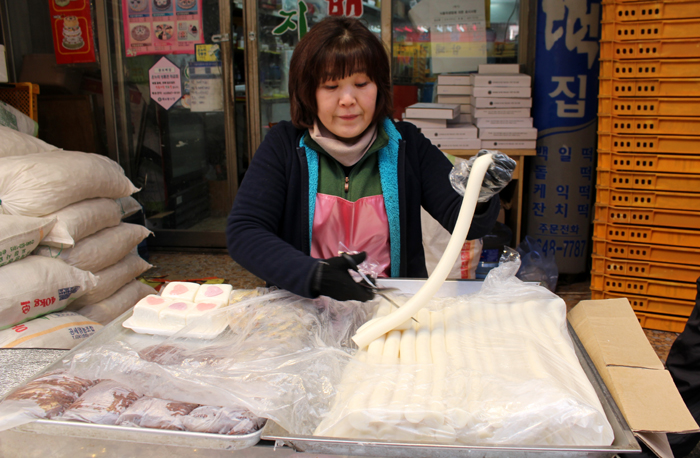
Families clad in traditional Hanbok have a bowl of hearty tteokguk soup made from fresh rice cake. People traditionally think that eating tteokguk adds one year to the eater’s age. There’s a time-worn joke that those who don’t have a bowl of tteokguk on Seollal won't grow a year older.
People also perform ancestral rites, a ceremony called a charye, to worship and bow to their grandparents and further ancestors. After the charye, they share all the food that had been placed on the table, such as fruit, bindaetteok, mung bean pancake, fried rice crackers, gangjeong, and traditional sikhye and sujeonggwa drinks.
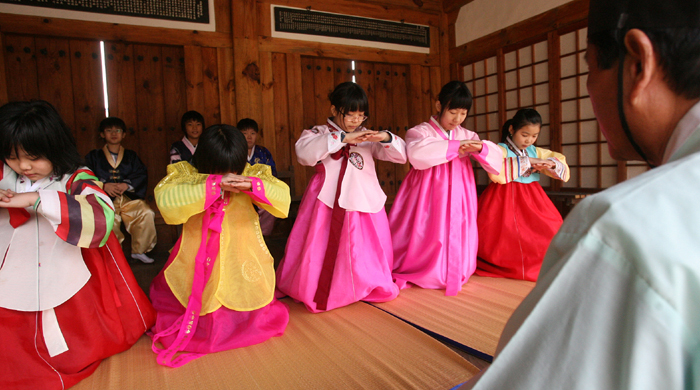
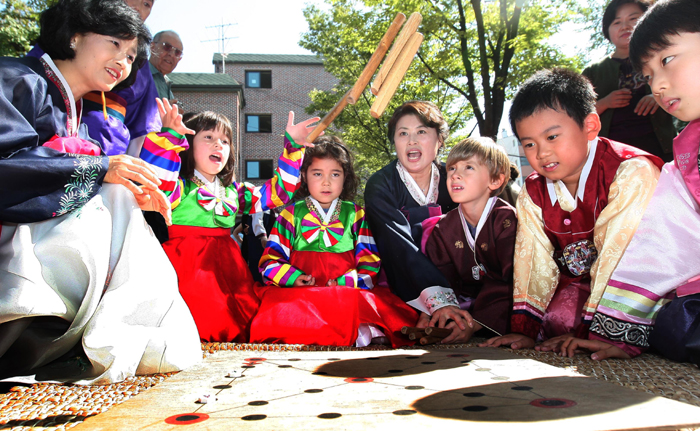
People also exchange blessings and greetings while performing another Seollal practice, the sebae. Younger members of the family usually give a deep bow, a sebae, to their elders. The elders, in turn, give words of blessing and cash, called sebaetdon, to their juniors.
People group together to play traditional games, too. Among the others, the four-stick board game yutnori is the most common, enjoyed by everyone regardless of age or sex. There are also the traditional see-saw neolttwigi and yeonaligi kite-flying, too.
By Sohn JiAe
Photos: Wi Tack-whan, Jeon Han
Korea.net Staff Writers
jiae5853@korea.kr
During the Seollal Lunar New Year's Day holiday, travelers who embark on their journey home, hoping to spend the five-day holiday with their loved ones, will face jam-packed train stations and bus terminals. On the road, there will be an endless march of vehicles crawling along at a snail’s pace.
Despite the logistical tie-ups, all travelers have an excited and eager air, as they look forward to soon reuniting with their family. Everyone travels with both hands full of Seollal gifts for grandparents, parents, siblings and relatives.

Seollal travelers board at Seoul Station.

Seoul Station is crowded with people buying train tickets home during the Seollal holiday.
Technically, this year’s Seollal holiday falls on Wednesday. February 18, and continues until February 20. The following weekend of February 21 and 22 gives people a five-day vacation.
Many people chose to take off the Monday and Tuesday, too, allowing for a much earlier mass exodus from Seoul.
According to the Ministry of Land, Infrastructure and Transport, some 33,540,000 people are predicted to migrate to their hometown across the nation during this holiday.
The figure increased by 15.7 percent over last year's figure, an increase of 4.56 million people. On February 19, the very day of Seollal, as many as 7.03 million people are expected to travel out of the capital.


The Seoul Express Bus Terminal is filled with travelers booking a ticket home for Seollal.
The solar new year starts on January 1, but in Korea, it’s still symbolically meaningful to celebrate the Lunar New Year,.
On Lunar New Year’s Day, people return to their hometown in earnest to spend the holiday with their families, who are scattered all over the country or the world.
A lot of traffic on the road makes the journey home take far longer than usual. For example, it takes twice or three times as long to travel from Seoul to Busan during the holiday. The trip normally takes four or five hours. Train tickets and bus tickets, too, sold out many weeks ago.

Many shoppers flock to Namdaemun Market to buy food items to be placed on the table when performing ancestral rites.
Traditional markets, too, are gearing up to welcome all the customers who come to buy traditional food items. These are placed on the table when people perform ancestral rites, part of the Seollal tradition.
Vendors are busy pulling out stacks of rice cake from the machine, known as a garaetteok. Rice cakes are the main ingredient of ttekguk, a rice cake soup traditionally eaten on Seollal. Hot, steaming bars of rice cake vary in color, from wine and green to yellow after the natural pigments were added, using cactus fruit, green tea powder, sweet potato and pumpkin.
Food for the ancestral rites, including special fish and fruit, is stacked neatly in baskets along each stall, ready to be placed on the table.

A vendor snips a bar of garatteok at a store that makes rice cake in Mokdong Market, Yangcheon-gu, western Seoul.
Families clad in traditional Hanbok have a bowl of hearty tteokguk soup made from fresh rice cake. People traditionally think that eating tteokguk adds one year to the eater’s age. There’s a time-worn joke that those who don’t have a bowl of tteokguk on Seollal won't grow a year older.
People also perform ancestral rites, a ceremony called a charye, to worship and bow to their grandparents and further ancestors. After the charye, they share all the food that had been placed on the table, such as fruit, bindaetteok, mung bean pancake, fried rice crackers, gangjeong, and traditional sikhye and sujeonggwa drinks.

Children practice giving a deep bow, a sebae, to their elders on Seollal.

A group of children dressed in traditional Hanbok play the traditional four-stick board game, yutnori, on Seollal.
People also exchange blessings and greetings while performing another Seollal practice, the sebae. Younger members of the family usually give a deep bow, a sebae, to their elders. The elders, in turn, give words of blessing and cash, called sebaetdon, to their juniors.
People group together to play traditional games, too. Among the others, the four-stick board game yutnori is the most common, enjoyed by everyone regardless of age or sex. There are also the traditional see-saw neolttwigi and yeonaligi kite-flying, too.
By Sohn JiAe
Photos: Wi Tack-whan, Jeon Han
Korea.net Staff Writers
jiae5853@korea.kr